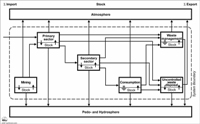|
The project aims at accounting for all sectors in the economy (Figure
1 shows a possible conceptual organisation of the system) the flows, stocks and linked environmental pressures to increase the reliability of source data used in “Life Cycle
Approaches” to waste management issues.
Waste policies influence the "primary production" due to recycling and
prevention, the "manufacturing and consumption" stages due to
recycling, reuse and prevention and the "waste management"
sector. The input/output (I/O) balance of each stage is (dynamically) linked to the
others.
As an example, figure 2 shows the situation of sand and gravels in
Austria. The net balance between the consumption and the stock (104-10
Tg/year) represent the net balance of the primary sector (105-9 Tg/year), which means that the evolution of this stock (age) is of primary importance for a policy aiming at resources
saving.
The difficulties of establishing that type of figure for resources saving in Europe are at two
levels:
 |
Data quality: considering the disparity of I/O country data quality in the
EU, it is anticipated to set out a global mapping of materials cycles in three
steps: 1) elaboration of a global model for matter balance applicable in all countries, 2) calculation of the so-called “transfer coefficients” with “reliable and
complete” country data (four countries), and 3) extension to EU-27 macro-economic data. |
 |
Completeness: considering the variety of
resources, and eventually associated secondary resources (as in ores), and their mixed occurrence in the
products, it will be necessary to combine the “materials flows and stocks
setting” approach with a more global Input/output modelling for individual countries and for
EU. |
Further, the objective is to forecast the waste generation in the next 25
years. The need is to establish a relation between stocks quantities and qualities and waste
generation, the core question being to estimate stocks life time for the different materials
(sand/gravel, wood, metals, paper, etc.), products and waste types, and interpret dynamically the causes of the variation of stocks (accumulation versus waste generation or dispersive
losses).
The results of this STREP will be based on real data derived from a “model
guided” broad an intensive data mining in each of the European countries. The country-specific data will feed a descriptive model of complex relationships between flows of
materials, stocks, waste and the environmental pressures associated to each link of the process
chains. All country-specific models will further be integrated to derive a European vision. As a
result, the following support can be given directly to policy and decision
makers:
 |
Estimation of the material stock of the EU-27.
|
 |
Overall mapping of environmental pressures of waste, enabling an understanding of the environmental issues of
waste;
|
 |
As a result of scenarios simulations, links
between the stocks and waste generation in terms of
quantities and quality/composition in the next 25 years.
|
 |
The identification of the costs and benefits
associated with:
-
the wastes for which prevention has the highest potential to reduce the environmental pressures on the use of
resources;
-
the wastes for which recovery or recycling has the highest potential to reduce the environmental pressures on the use of
resources; and
|
Additionally, the “leaks” of materials in the system above mentioned as “uncontrolled waste
disposal” in figure 1 point out the difficulties in making reliable balances on materials
life-cycle. These quantified data anyhow allow the drawing of tracks of
interpretation. These will be explored providing the knowledge gaps to be filled for assessing the environmental impacts over the entire life cycle including dispersive losses of the physical stocks to the environment (e.g. corrosion and
weathering) and losses of materials as a result of materials management (e.g. transport and
processing), including energy use of recycling.
|
|

|
|
Figure 1. Conceptual system description.
|
|

|
|
Figure 2. Materials balance for sand and Gravel in Austria 2001. |
|


